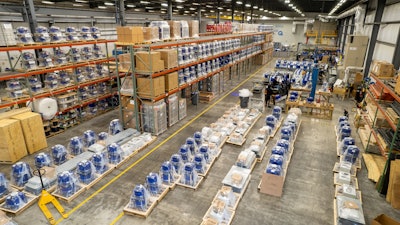
Tracking the sales cycle is a fundamental business process. The quote-to-cash process represents all the individual business activities happening across the entire sales cycle — from the initial price estimate (quote) to the final payment collection (cash). A well-run quote-to-cash cycle is particularly important to industrial distributors because it’s how they get the right products into customers’ hands on time and build a strong base of loyal clients.
But this cycle is slightly different for every industrial distributor. Some fulfill orders from inventory by forecasting demand. Others use outsourced order fulfillment, drop-shipping and third-party inventory management while investing heavily in marketing and sales. And, of course, none of these processes are handled exactly the same way across organizations. They’re customized according to individual business needs.
Trying to handle all quote-to-cash activities manually or with disconnected applications impedes growth. Industrial distributors operating this way end up selling less product, getting paid more slowly, and working with less cashflow because their methods can’t keep up with the speed of business in today’s digital economy.
But industrial distributors can turn this around — selling more, getting paid faster, and improving cash flow — by implementing modern distribution management technology built to streamline and automate the quote-to-cash cycle.
What features should industrial distributors look for in a modern business application? We’ll talk about four critical considerations today.
1. Embedded Customer Relationship Management Capabilities
Marketing and sales teams work diligently to generate leads and turn prospects into loyal, returning customers. But all that work goes to waste if the business can’t save, organize, and analyze prospect and customer information over time. Embedded customer relationship management (CRM) features in a distribution management system should empower users to:
- Import and manage marketing lists for email, direct mail, telemarketing, and other types of outreach campaigns.
- Create and execute marketing activities with tasks and events.
- Harness customer data — like previous order information — to improve campaign plans.
- Schedule tasks, add notes, and attach documents to organize customer and prospect data in one accessible place.
- Monitor the sales pipeline with key performance indicators through built-in, automated workflows.
Obviously, there is no quote-to-cash cycle without customers to sell to, which is why getting CRM right is such a critical step for industrial distributors.
2. Automated Quote Creation
The quote-to-cash cycle also can’t exist in the absence of quotes. Because they are so foundational, they are also difficult to manage. They must be generated carefully and accurately because they serve as the base for a business’s entire relationship with a customer. For industrial distributors, quotes may vary drastically from sale to sale depending on project size and contract type — further complicating the process. The right distribution management system will help companies automate multiple quote types, including sales, service, support, project, and B2B commerce quotes. For instance, the system should be able to automatically:
- Apply the best specified discount combination for individual items.
- Forward discount approvals for quotes or orders to supervisors on the go.
- Estimate shipping costs, taxes, landed costs, and other factors for accurate quotes.
- Convert quotes to projects, contracts, appointments, or sales orders with options to activate tasks, include notes and files, and link activities.
The solution should also easily integrate with third-party applications, like DocuSign, to automate quote approvals and save signed copies to the in-system quote record.
3. Improved Warehouse Operations
Item procurement and order fulfillment are at the center of any industrial distribution business. But, like generating quotes, they’re also very complicated. Accomplishing them well can create a profitable business with lifelong customers, while mistakes can lead to lost revenue opportunities, dead stock inventory, and dissatisfied customers who move to competitors. A modern distribution management system should improve these warehouse operations in three major ways:
- Inventory Planning: Providing a place to store and reference traditional demand forecasts with tools for using historical data and advanced statistical models to predict future demand for optimized inventory levels.
- Purchasing: Automating and centralizing procurement processes to ensure a steady supply of materials while enforcing policy and process controls.
- Flexible Pick, Pack and Ship Processes: Offering both simple and advanced order fulfillment features, from single-step pick, pack, and ship activities to paperless wave and batch picking using carts and staging areas for shipment preparation.
This helps get the right orders into the right customers’ hands on time. It also keeps industrial distributors from spending money on excess, unneeded stock or running out of high-demand items.
4. Automated Accounting
Every industrial distributor needs to manage cash effectively, and the accounting department engages in the quote-to-cash cycle at various points for invoicing, vendor payments, and related activities. Done manually, accounting can be very time-consuming and prone to human error. But, with distribution management software, industrial distributors can rely on powerful automation to ensure all their accounting needs are filled quickly and correctly—every time. Such a system should automatically:
- Sync vendor invoices for products and services from email or via connected EDI applications.
- Use artificial intelligence and machine learning to identify vendor names, items, prices, payment terms, and other invoice details from files or scanned documents.
- Generate invoices from customer shipments and projects.
- Harmonize transactions from banks and lending institutions.
- Sync financial data entered in other system modules to the general ledger.
- Track transactions across business entities, including sales, inventory, purchasing, projects, and services.
- Send text or email notifications for low inventory stock, late orders, large sales orders, upcoming expiration dates, outstanding customer payments, etc.
Beyond these functions, a strong distribution management system provides business intelligence features, role-based dashboards with real-time data, and integrated payment processing that makes it easier for customers to pay bills via links or QR codes.
James Mallory is the senior product marketing manager, supply chain applications at Acumatica Inc. For more in-depth information on what the quote-to-cash process looks like with modern, streamlined software, read Acumatica’s free eBook: “Perfecting Distribution and Retail Quote-to-Cash Processes with Acumatica.”






















